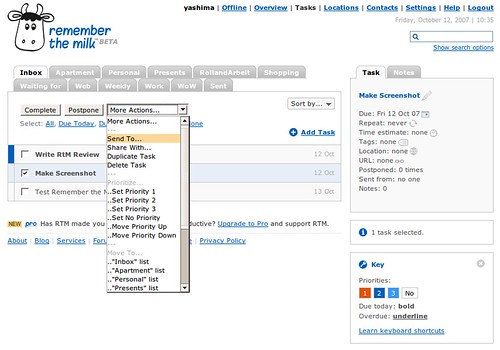This is not the first time, more like the 8th, that I've been rescoped on my current project assignment.
It doesn't bother me per se, but makes me a bit worried about how my client is viewing my work and WHY they keep asking me to shift gears.
This time I'm doing what can loosely be titled as "operational analysis". What I'm truly doing is a survey of all the activities (non-minor work) within my client's organization, mapping all that work to their four strategic goals (and sub-goals), and doing a standard gap analysis to determine if there is any under/over-investment of time and resources.
This has the *potential* to be rather important. If the results determine that they are under-investing in their strategic goal to develop the skills of their workforce (fourth goal, but what the client leader described at their senior leadership offsite a week ago as priority #1) then they will need to re-scope their work and level of effort.
Saturday, July 25, 2009
Sunday, July 19, 2009
Wednesday, July 15, 2009
How should a consulting company use Twitter?
 We don't have constant feedback from customers, nor would they provide it publically online. We don't sell a product, so there aren't hundreds of reviews a day to keep tabs on.
We don't have constant feedback from customers, nor would they provide it publically online. We don't sell a product, so there aren't hundreds of reviews a day to keep tabs on.As a consulting services company, what should we be worried about regarding competitive intelligence? What information could we publish that a competitor could use against us? Could they use it to "ghost" us in proposals?
Are there potential legal issues since we work with the government? Could we create some sort of "conflict of interest" or disclose information that can't be in the public domain?

Seems like it would end up being mostly one-directional: us pushing content out. Which can be useful, especially if there are actually people interested.
I think we can readily Tweet:
- When a new employee joins us, not their name though. And probably not a specific client, but maybe a skillset and experience
- When an employee wins an award or is recognized in some capacity by a client
- When an employee wins an award or is recognized in some capacity by our company
- When an employee completes training or certification
- Some level of information when we win a new contract
It was covered here, there are a few good tidbits in it. I'm not sure we'd be looking to build the brand of partners/executives. If you are trying to portray them as industry "though leaders" then maybe so.
Pics by mfilej, and Matt Hamm, respectively.
People please, reply without attachments
 For better or worse I have to use Lotus Notes on my client site.
For better or worse I have to use Lotus Notes on my client site.As with all work environments, there are a lot of discussions that take place via email. Often times email attachments are involved.
What happens when 10 people continually send responses in an email thread, never removing previous attachments, while adding more? You get a 10MB file being emailed back and forth over forty times. It stinks. A lot.
It's not that hard to fix - "Reply without attachments". Now sure, sometimes an attachment previously sent is important, you may have to ask someone to refer to the attachment and feel you are making their life easier by including said attachment. I feel that is a rare occurence though, and people can quite easily just refer to the previously sent email.
If you are using Gmail, this is extremely easy. With Outlook, not that hard. With Lotus Notes it is actually fairly easy as they have their own version of threaded conversations.
Friday, July 10, 2009
Twitter full name is too long?
You give people 20 characters for their full name? I know you're doing this whole 140 characters thing, but 20 characters for a full name? I didn't even use a middle initial and my real name ran too long.
Boo.
Boo.
One of the keys to sticking with a to do list
 Habit. Plain and simple, there is no magical special answer. Sure, there is some effort involved in this, but the key is to remove barriers so that using your to do list becomes a habit.
Habit. Plain and simple, there is no magical special answer. Sure, there is some effort involved in this, but the key is to remove barriers so that using your to do list becomes a habit.How do I do this?
For me, I use Remember the Milk, and have loved it intermittently for over two years. When I use it, it works great. Web-enabled, easy to use, easy mobile integration, even the print out to carry around to meetings is darn good.
I have made it a habit (again) by having it auto start when I crank up Firefox (typically via the "quit and save" feature). This way, whenever I open up my browser (which is the first thing I do when I get to work) it pops up and is staring at me.

For some reason on my client site, with the client provided PC, the Remember the Milk integration into Gmail isn’t working. It isn’t keeping me logged in on that page, though it works just fine at RTM’s site. I dunno. I thought it was a cookie issue, but if it is keeping me logged into RTM during the course of the day (and after a reboot) I don’t see that as the problem.
The inertia is removed from me using my to do list. It’s right there every morning, staring me in the face. I can’t help but use it.
"To do list" by ebby, "RTM" pic by yashima
Government contradictions, insourcing and hiring freezes
The Obama administration has made it very publicly known of their intentions to "insource" a lot of jobs being done by contractors. Typically this is in reference to positions viewed to be "inherently governmental". And I would/will applaud this, there are clear lines that need to be drawn between what roles can or cannot be performed by contractors.
However, to then make it known that there might be hiring freezes? How can this work? There are already hundreds if not thousands of vacant positions within DHS alone. If you are going to freeze hiring, you either have to rely more heavily on contractors, or leave a giant flapping hole in the services provide the country. And doing so within the DHS space has the unfortunate risk of leaving us vulnerable to various attacks, increased crime or lack of response to a natural disaster (and with H1N1 looming…).
There's clearly no simple solution, but it has to involve common sense, maximum value for the taxpayer's dollar, and the necessary services to keep our country safe.
However, to then make it known that there might be hiring freezes? How can this work? There are already hundreds if not thousands of vacant positions within DHS alone. If you are going to freeze hiring, you either have to rely more heavily on contractors, or leave a giant flapping hole in the services provide the country. And doing so within the DHS space has the unfortunate risk of leaving us vulnerable to various attacks, increased crime or lack of response to a natural disaster (and with H1N1 looming…).
There's clearly no simple solution, but it has to involve common sense, maximum value for the taxpayer's dollar, and the necessary services to keep our country safe.
Monday, July 6, 2009
181 subscriptions, 6971 read items
From your 181 subscriptions, over the last 30 days you read 6,971 items, starred 58 items, shared 68 items, and emailed 60 items.
Last 30 days:
| |
Friday, July 3, 2009
Remembering basketball camp

by Zador Spanish schools Spain
- My Mom packing my lunch in the grey and blue cooler that I still have. She always put an icepack in their to keep things cool. There was always a Gatorade (orange). A sandwich of some sort. Usually an apple as well. And my name was on the cooler on masking taping - "C. Stevenson"
- It was HOT! We did a good bit of practicing outside on the blacktop. Drills mostly, but games as well.
- I got pick on a bit, and one time really still is fairly vivid in my memory. I had on an Adidas shirt, and this was during their “All Day I Dream About Sports” ad campaign. Well one kid who I guess didn’t like me turned the “Sports” into “S**” and said I liked that. Now for an 8 year old boy, that was a bit disturbing. He, I guess, expected me to get really upset about it. But I played it cool, only replying “So?”. But it still bothers me and I remember how scared I was at the time.
- The head coach had a really really shiny bald head. I mean SHINY!
- The rebounding and shooting contraption. They had this device that you set up around a basket, it had netting on it that forced you to shoot with a minimum amount of arc (a good idea), and it also had three ball return chutes the get you the ball (also cool). It was giant to a small guy like me, but I loved that thing. I could shot 3’s all day by myself.
- I remember how excited I always was for lunch. Maybe my most favorite part of the day.
- 4-square! We played that a lot, I think during lunch. That was a fun game. Had to use the big red bouncy balls (also a must for kickball), and there were all these weird rules about special bounces you could earn and use. I didn’t get that part of the game. Evidently one of them was where you could grab the ball and two handed slam it in someone’s square. I hated that.
- The basketball coach also had really short shorts, the old school coach lycra material one’s. Awesome.
- I was always extremely excited to see my Mom when she picked me up.
I loved that camp, it was a lot of fun and I truly learned a lot about basketball. Up until a certain age (I think 12 or 13) I tended to be one of the top 2 or 3 kids in my age group. I was an all-star. Something happened when I was 12 or 13, I think I moved up an age bracket. But I was on a new team where all the kids new each other and were “cool”. I felt like an outsider and a dork. I went from a whirling dervish scorer, to a pass only point guard.
Thursday, July 2, 2009
It's time to get ride of the corner office
 or
or 
In the course of my modest nearly 8 year career (July 9th will be the 8 year anniversary, which is the bronze year evidently), I've been able to work with some facilities organizations. Facilities? You mean the janitors and maintenance crews? Yes, those guys, plus a lot lot more. Managing corporate real estate is a large task, as it involves a heavy dollar investment for any organization.
The cost per square foot is rather shocking, and when you look at it on an annual basis, wow is that a lot of money.
All that beind said, the corner office holds a special place within corporate America. Long viewed as the symbol of "making it" in the business world, corner offices are the modern day anethema to green/sustainable work places. Corner offices block sunlight, leaving the lowly peons of the organization with fluorescent lighting. Corner offices alone as a status symbol cause devisiveness, tension and angst among workers.
Peers can become rivals when space planning and real estate demands result in one equal getting a corner office and the other not. Friendships have actually ended over this stuff.
If an organization's leaders claim to put their people first, claim that they want to create an open environment where people are valued, etc then check to see where their office is located.
Also, check out how large and lavish the CEO/President's office is in comparison to everyone else...
(pictures by redskins5926 and bellhalla, respectively)
Wednesday, July 1, 2009
How to survive a large business proposal, part 1
The best term I learned early in my career was "frontload". A very basic concept, the term means do as much as you can, early in the process. This is obviously the opposite of cramming. Cramming in the workplace is not fun, creates a poor quality product, results in error prone work, and creates unnecessary stress that often times requires you to burn your limited number of favors.
Cramming on the job means that there was deficient planning somewhere in the chain. Even if the cramming is a result of new unplanned for demands from superiors (which my wife can attest to), we can still frontload the new task. Frontloading can be done on almost any proposal, and I would question the merit of any proposal where you can't frontload.
The only instance where this would occur is if you were bidding on a totally new "thing" (service or product to provide) and had a very short timeline. And the only time you'd want to bid in a situation like this if your company were facing a profitability issue (maybe it's because you are bidding on the wrong RFPs?) or you had the inside track to the opportunity (in which case you have to wonder why they couldn't sole source this).
If you are lucky/cursed enough to have a Request for Proposal (RFP), make sure you read it over. Understand what they are asking for. Observe how they have provided you with a natural outline. Outline? Yeah, they order and way in which they ask questions. Make it easy for them. they'll likely have a checklist of things to find in your proposal, it'll be based on the RFP. So use their own words and order.
Plan plan plan.
Create a "compliance checklist" now. This is a list of all the little nitnoid items you need to include. They often list out a few phrases you are required to include in your proposal (or else you are noncomplient and tossed out). These are almost always obvious things like "We don't discriminate", but they are required. But also make sure you notice all the attachments they want, the font size they require, the handful of items they want you to include in an answer.
Now, take that checklist, and add to it. Add? It's already 4 pages long! Well, it needs more stuff, and these things are what will help you win.
You need to figure out what "win themes" you'll include in each section, and you'll need to include what "over achiever" answers you'll provide as well. "Win themes" are your high-level selling points. Examples might be "We've done this exact work with other clients" or "We have the most experience people in the industry" or ideally "We have the exact technology you need".
Make sure each section of your proposal has at least one win theme (the longer the section, the more Win Themes it needs). This checklist will be key when you get to the end of the process. Your brain will be fried, and you won't really be able to read the RFP again and understand it.
Your compliance checklist will be your sane self's way of helping you out.
Cramming on the job means that there was deficient planning somewhere in the chain. Even if the cramming is a result of new unplanned for demands from superiors (which my wife can attest to), we can still frontload the new task. Frontloading can be done on almost any proposal, and I would question the merit of any proposal where you can't frontload.
The only instance where this would occur is if you were bidding on a totally new "thing" (service or product to provide) and had a very short timeline. And the only time you'd want to bid in a situation like this if your company were facing a profitability issue (maybe it's because you are bidding on the wrong RFPs?) or you had the inside track to the opportunity (in which case you have to wonder why they couldn't sole source this).
If you are lucky/cursed enough to have a Request for Proposal (RFP), make sure you read it over. Understand what they are asking for. Observe how they have provided you with a natural outline. Outline? Yeah, they order and way in which they ask questions. Make it easy for them. they'll likely have a checklist of things to find in your proposal, it'll be based on the RFP. So use their own words and order.
Plan plan plan.
Create a "compliance checklist" now. This is a list of all the little nitnoid items you need to include. They often list out a few phrases you are required to include in your proposal (or else you are noncomplient and tossed out). These are almost always obvious things like "We don't discriminate", but they are required. But also make sure you notice all the attachments they want, the font size they require, the handful of items they want you to include in an answer.
Now, take that checklist, and add to it. Add? It's already 4 pages long! Well, it needs more stuff, and these things are what will help you win.
You need to figure out what "win themes" you'll include in each section, and you'll need to include what "over achiever" answers you'll provide as well. "Win themes" are your high-level selling points. Examples might be "We've done this exact work with other clients" or "We have the most experience people in the industry" or ideally "We have the exact technology you need".
Make sure each section of your proposal has at least one win theme (the longer the section, the more Win Themes it needs). This checklist will be key when you get to the end of the process. Your brain will be fried, and you won't really be able to read the RFP again and understand it.
Your compliance checklist will be your sane self's way of helping you out.
Subscribe to:
Comments (Atom)
